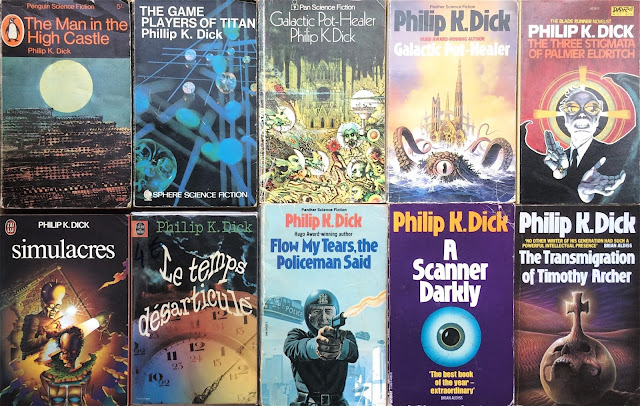 While the pulp SF market was resistant to change, having employed the same methods successfully since the inception of the genre, Dick’s work gradually gained more literary credibility, especially in Europe. The production values of several foreign-language editions suggested an attempt to capture some of the depth which critics were beginning to detect. By the end of the 1960s and early 70s, though Dick himself had already written the bulk of his novels, the seeping of the counter-culture, the esoteric and the experimental, into the mainstream was apparent. The influences of pop-art, psychedelia and surrealism began to be manifested on book covers, with Philip K. Dick ripe for such treatment. The US Daw edition of 1965’s The Three Stigmata of Palmer Eldritch, a favourite of John Lennon’s, is a classic of its type; no wonder the German translation of the same book was rendered as LSD-Astronauts.
While the pulp SF market was resistant to change, having employed the same methods successfully since the inception of the genre, Dick’s work gradually gained more literary credibility, especially in Europe. The production values of several foreign-language editions suggested an attempt to capture some of the depth which critics were beginning to detect. By the end of the 1960s and early 70s, though Dick himself had already written the bulk of his novels, the seeping of the counter-culture, the esoteric and the experimental, into the mainstream was apparent. The influences of pop-art, psychedelia and surrealism began to be manifested on book covers, with Philip K. Dick ripe for such treatment. The US Daw edition of 1965’s The Three Stigmata of Palmer Eldritch, a favourite of John Lennon’s, is a classic of its type; no wonder the German translation of the same book was rendered as LSD-Astronauts. 
Sadly Dick died in 1982, on the cusp of wider recognition, shortly before the release of Blade Runner brought his work to a whole new audience. Based on his 1968 novel Do Androids Dream of Electric Sheep?, the film’s success gave rise to an ongoing succession of lavish Hollywood adaptations. From Total Recall to Minority Report, several of the novels and stories which inspired them have since been given the ‘movie tie-in’ cover. Richard Linklater’s 2006 film of A Scanner Darkly, an ambitious ‘rotoscope’ animated version of Dick’s dystopian vision of societal breakdown and drug-induced paranoia, was also issued as a graphic novel. However, since his death, few publishers have surely even considered issuing Philip K. Dick’s novels with illustrations of rocket-fire and spaceships.






No comments:
Post a Comment